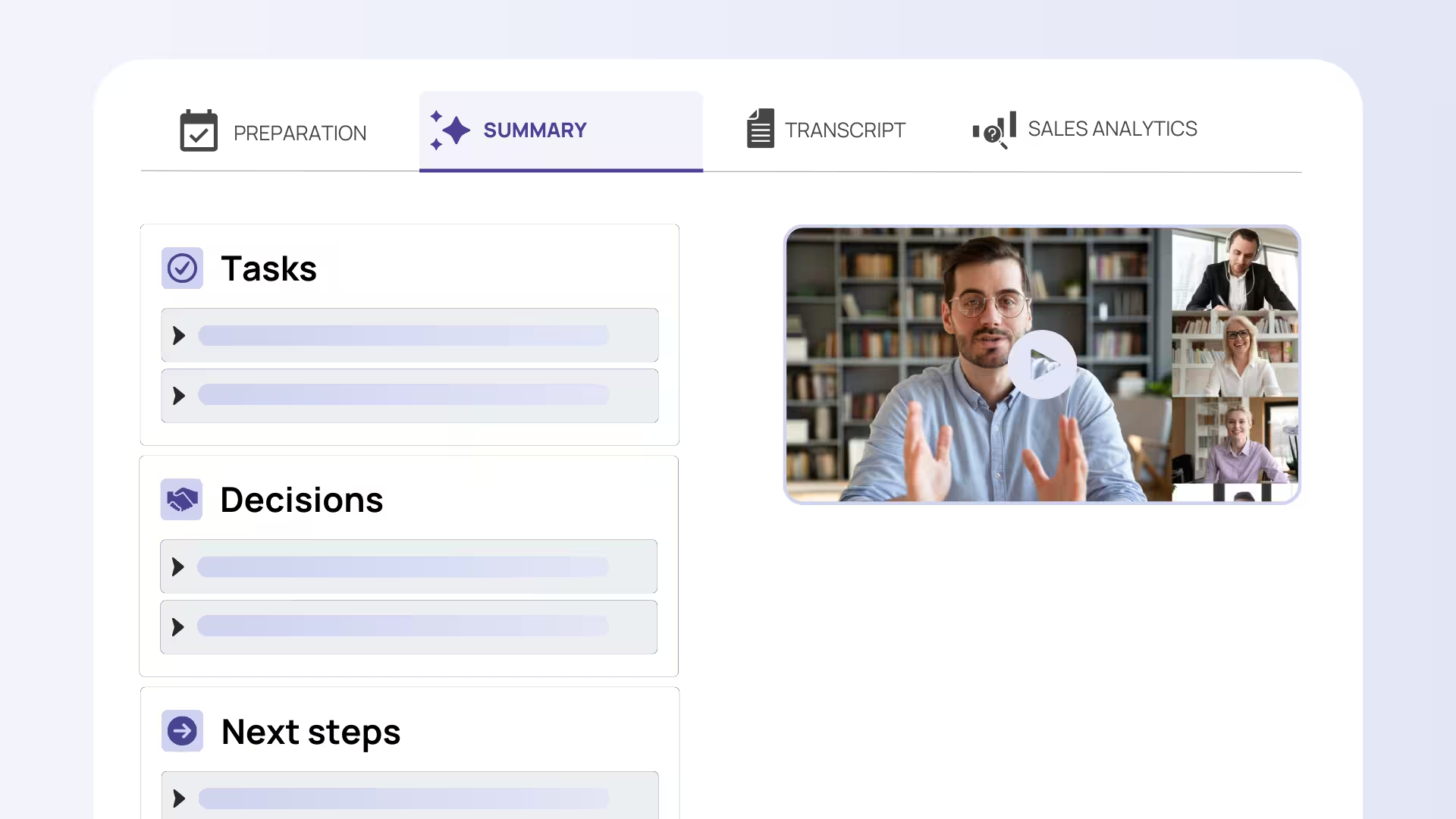Table of Contents
Understanding the Power of a War Room Meeting
When urgent challenges demand immediate attention and swift action, traditional meeting formats often fall short. War room meetings provide a powerful solution—creating an intensive, focused environment where cross-functional teams can collaborate effectively to solve complex problems and make critical decisions quickly.
Originally developed in military command centers, war room meetings have evolved into essential tools for modern businesses, IT departments, and crisis management teams. These specialized sessions break down silos, accelerate decision-making, and foster unprecedented transparency across organizations.
Unlike regular meetings, war rooms create an environment of concentrated effort where teams can tackle product launches, resolve technical incidents, manage crises, and drive continuous improvement initiatives. The integration of modern technology—including AI-driven tools like Sally for meeting documentation and analysis—has further enhanced their effectiveness in today's digital workplace.
What Is a War Room Meeting? Definition and Purpose
Definition and Core Objectives
A war room meeting is a centralized, high-intensity collaborative session where cross-functional teams gather to address urgent, complex challenges. These sessions prioritize real-time communication, rapid problem-solving, and immediate alignment across departments.
The concept originated in military command centers where strategic decisions required immediate coordination among different units. Today's business war rooms adapt this principle, creating dedicated spaces—physical or virtual—where teams can focus intensively on critical issues without the typical distractions of daily operations.
The core objectives include eliminating communication delays, breaking down departmental barriers, and establishing shared accountability for outcomes. Teams work collaboratively toward specific, time-bound goals with clear success metrics.
Typical Use Cases Across Industries
War room meetings prove invaluable across diverse business scenarios. Product launches benefit from war rooms when teams need to coordinate marketing, engineering, sales, and support functions under tight deadlines. Technology companies frequently use war rooms for incident response, bringing together developers, operations, and customer service teams to resolve system outages quickly.
Crisis management situations—from supply chain disruptions to public relations challenges—rely on war rooms to coordinate response efforts across multiple departments. Manufacturing companies leverage war rooms for continuous improvement initiatives, incorporating Lean and Agile practices to optimize processes and eliminate waste.
Financial services organizations use war rooms during regulatory compliance initiatives, while healthcare systems deploy them for emergency response coordination and patient safety improvements.
Differentiating War Room Meetings from Regular Meetings
War room meetings distinguish themselves through intensity and focus. While regular meetings might last an hour with broad agendas, war rooms operate with clear time boundaries and specific objectives. Participants commit to extended, concentrated work sessions with minimal external interruptions.
Visual management takes center stage in war rooms. Teams use whiteboards, digital dashboards, and progress trackers to maintain real-time visibility of developments. This visual approach contrasts sharply with traditional meeting formats that rely primarily on verbal discussion and slide presentations.
The emphasis on rapid feedback and iterative problem-solving creates a dynamic environment where solutions emerge through collaborative brainstorming rather than hierarchical decision-making.

Setting Up an Effective War Room Meeting
Physical and Virtual War Room Configurations
Successful war rooms require thoughtful space configuration. Physical war rooms need dedicated areas equipped with multiple whiteboards, large displays, and comfortable seating arrangements that encourage collaboration. The space should allow team members to move freely between individual work and group discussions.
Virtual war rooms have gained prominence, especially following remote work trends. Platforms like Microsoft Teams, Miro, and Jira provide comprehensive digital collaboration environments. These virtual spaces integrate real-time document sharing, video conferencing, and digital whiteboarding capabilities.
Hybrid configurations combine physical presence with remote participation, using technology to ensure all team members can contribute effectively regardless of location. This approach requires careful attention to audio-visual quality and engagement strategies for remote participants.
Essential Resources and Tools
Effective war rooms depend on robust visual management tools. Physical spaces need multiple whiteboards, sticky notes, markers, and flip charts. Digital environments require subscription access to collaboration platforms, shared document systems, and project management tools.
Communication infrastructure forms the backbone of war room operations. Reliable internet connectivity, video conferencing capabilities, and instant messaging systems ensure seamless information flow. Specialized software like War Room Pro, Hive, and Lucid Charts provide purpose-built environments for intensive collaboration.
AI-powered tools increasingly support war room effectiveness. Meeting assistants like Sally can automatically transcribe discussions, generate summaries, and create action item lists, allowing participants to focus entirely on problem-solving rather than documentation.
Building the Right Team
War room success depends heavily on team composition. Cross-functional representation ensures diverse perspectives and comprehensive expertise. Each department affected by the challenge should have skilled representatives who can make decisions and commit resources.
Clear role assignments prevent confusion and overlap. Teams need designated facilitators to guide discussions, subject matter experts to provide technical insights, and decision-makers with authority to approve solutions. Supporting roles might include scribes, timekeepers, and resource coordinators.
Psychological safety becomes crucial in war room environments. Team members must feel comfortable sharing problems, admitting mistakes, and proposing unconventional solutions without fear of judgment or retribution.

Benefits and Effectiveness of War Room Meetings
Accelerated Decision-Making and Problem Resolution
Organizations implementing war room approaches report significant improvements in issue resolution times. Studies indicate that teams can resolve complex problems 30-40% faster through intensive collaboration compared to traditional meeting structures.
Real-time collaboration eliminates the typical delays associated with scheduling multiple meetings, waiting for email responses, and coordinating across departments. Teams can identify problems, brainstorm solutions, and implement changes within single sessions.
The concentrated focus reduces context switching and allows teams to maintain momentum on challenging problems that might otherwise stagnate in regular workflow patterns.
Enhanced Team Alignment and Transparency
War rooms create unprecedented visibility into project progress and challenges. Visual management tools allow all participants to see current status, obstacles, and next steps simultaneously. This transparency reduces duplicative efforts and promotes shared accountability.
Teams develop stronger working relationships through intensive collaboration. The shared experience of solving difficult problems together builds trust and improves future cooperation across departments.
Clear communication protocols established in war rooms often improve overall organizational communication practices, creating lasting benefits beyond individual projects.
Driving Continuous Improvement and Agility
War rooms naturally incorporate Lean Six Sigma principles through iterative feedback loops and continuous process refinement. Teams can identify inefficiencies, test solutions, and measure results in real-time.
The intensive collaboration builds organizational learning and preparedness for future challenges. Teams develop crisis response capabilities and problem-solving skills that benefit subsequent projects.
Measurable organizational gains include improved time-to-market for products, reduced incident response times, and enhanced customer satisfaction scores.
Challenges and Practical Solutions
War room intensity can lead to participant fatigue and decreased engagement over extended periods. Solutions include scheduled breaks, rotation of responsibilities, and clear time boundaries to maintain productivity.
Role ambiguity sometimes creates confusion about responsibilities and decision-making authority. Establishing clear role definitions and rotating leadership responsibilities can mitigate these issues.
Virtual war rooms face technical challenges including connectivity issues, platform limitations, and engagement difficulties. Pre-meeting technical checks, backup communication methods, and proactive facilitation strategies help overcome these obstacles.
Cultural sensitivity around military terminology affects some organizations. Alternative naming conventions like "focus room," "mission control," or "collaboration center" can maintain the intensive approach while respecting diverse workplace cultures.
Best Practices for Running Successful War Room Meetings
Preparation and Planning
Successful war rooms begin with precise objective definition and clear success criteria. Teams must understand exactly what they're trying to achieve and how they'll measure progress.
Time limits and structured agendas maintain focus and urgency. Without clear boundaries, war rooms can become unproductive marathon sessions that exhaust participants without delivering results.
Technical preparation includes testing all systems, preparing backup resources, and ensuring all participants have necessary access credentials and training.
Facilitating Effective Sessions
Skilled facilitation makes the difference between productive collaboration and chaotic discussion. Facilitators guide conversations, manage time, and ensure all voices are heard while maintaining focus on objectives.
Inclusive discussion practices encourage participation from all team members, regardless of seniority or personality type. Structured brainstorming techniques and anonymous input methods can improve idea generation.
Visual aids should be used actively throughout sessions, not just for final presentations. Real-time documentation of ideas, decisions, and action items keeps teams aligned and creates valuable reference materials.
Leveraging Technology for Efficiency
AI-driven transcription and summarization tools like Sally can capture key discussions automatically, allowing participants to focus entirely on problem-solving rather than note-taking. These tools integrate seamlessly with project management systems for follow-up action tracking.

Dynamic platforms that allow real-time updating ensure all participants have current information. Integration with existing workflow tools maintains continuity between war room decisions and ongoing operations.
Automated alerts and progress tracking help teams stay focused on priorities and deadlines without requiring constant manual monitoring.
Monitoring Outcomes and Continuous Evaluation
Success metrics should include both immediate outcomes and longer-term impacts. Resolution speed, team alignment scores, and post-implementation performance all provide valuable feedback.
Retrospective reviews capture lessons learned and identify improvement opportunities for future war rooms. These sessions should occur shortly after war room completion while experiences remain fresh.
Organizations should adapt war room structures based on feedback and changing needs. What works for small teams might require modification for larger groups or different types of challenges.
Adapting War Room Meetings for the Future
Scalability for Larger Organizations and Diverse Industries
Modular war room setups allow organizations to scale approaches based on project complexity and team size. Larger initiatives might require multiple connected war rooms with coordination protocols.
Multi-team coordination through linked virtual rooms or structured breakout sessions enables enterprise-wide problem-solving while maintaining the focused intensity of smaller groups.
Industry-specific adaptations recognize that technology companies, healthcare organizations, and manufacturing firms face different challenges requiring tailored approaches to war room implementation.
Emerging Trends: AI and Analytics Integration
AI-powered decision support systems can analyze vast amounts of data to provide real-time insights during war room sessions. Predictive analytics help teams anticipate potential issues and prepare proactive solutions.
Automated risk assessment tools can continuously monitor project parameters and alert teams to emerging problems before they become critical. This capability transforms war rooms from reactive to proactive environments.
Integration with AI meeting assistants provides automated documentation, action item tracking, and follow-up reminders, reducing administrative burden and improving accountability.
Cultural Considerations and Inclusive Language
Organizations increasingly recognize the importance of terminology choices in creating inclusive workplace cultures. The military origins of "war room" language can feel exclusionary or aggressive to some team members.
Alternative terminology like "focus room," "collaboration center," or "mission control" maintains the intensive problem-solving approach while promoting more inclusive communication.
Balancing urgency with respectful communication requires thoughtful facilitation and clear behavioral expectations that support both rapid decision-making and psychological safety.
Conclusion: Unlocking the Full Potential of War Room Meetings
War room meetings represent a powerful approach to focused collaboration and rapid decision-making in today's complex business environment. When properly implemented with skilled facilitation, appropriate technology, and clear objectives, they can dramatically accelerate problem resolution and enhance team alignment.
Success depends on thoughtful preparation, the right team composition, and commitment to continuous improvement. Organizations must invest in proper setup, whether physical, virtual, or hybrid, and provide teams with effective tools and training.
Modern technology integration, including the AI-powered tool Sally for documentation and analysis, can significantly enhance war room effectiveness while reducing administrative burden. The key lies in balancing intensive focus with sustainable practices that support long-term organizational learning and capability development.
As businesses face increasingly complex challenges requiring rapid response, war room meetings offer a proven framework for bringing together diverse expertise, accelerating decision-making, and driving measurable results. Organizations that master this approach will be better positioned to thrive in dynamic, competitive environments.

Try meeting transcription now!
Experience how effortless meeting notes can be – try Sally free for 4 weeks.
Test NowOr: Arrange a Demo Appointment

.avif)



